University Name: A Culture of Patient Safety in SICU Report
VerifiedAdded on 2022/11/19
|9
|2077
|411
Report
AI Summary
This report delves into the critical aspects of patient safety culture within a SICU, examining factors that contribute to both positive and negative patient outcomes. It highlights the importance of evidence-based practices, effective teamwork, and clear communication in fostering a safer healthcare environment. The report analyzes a case study involving Mrs. Jackson, whose experiences underscore the need for improvements in care delivery. It discusses the demand for change, the framework used, and the application of the Lewin change management model to implement necessary changes. The report emphasizes the significance of communication and employee engagement in achieving successful and sustainable improvements in patient safety, ultimately aiming to enhance the quality of care and prevent avoidable adverse events.
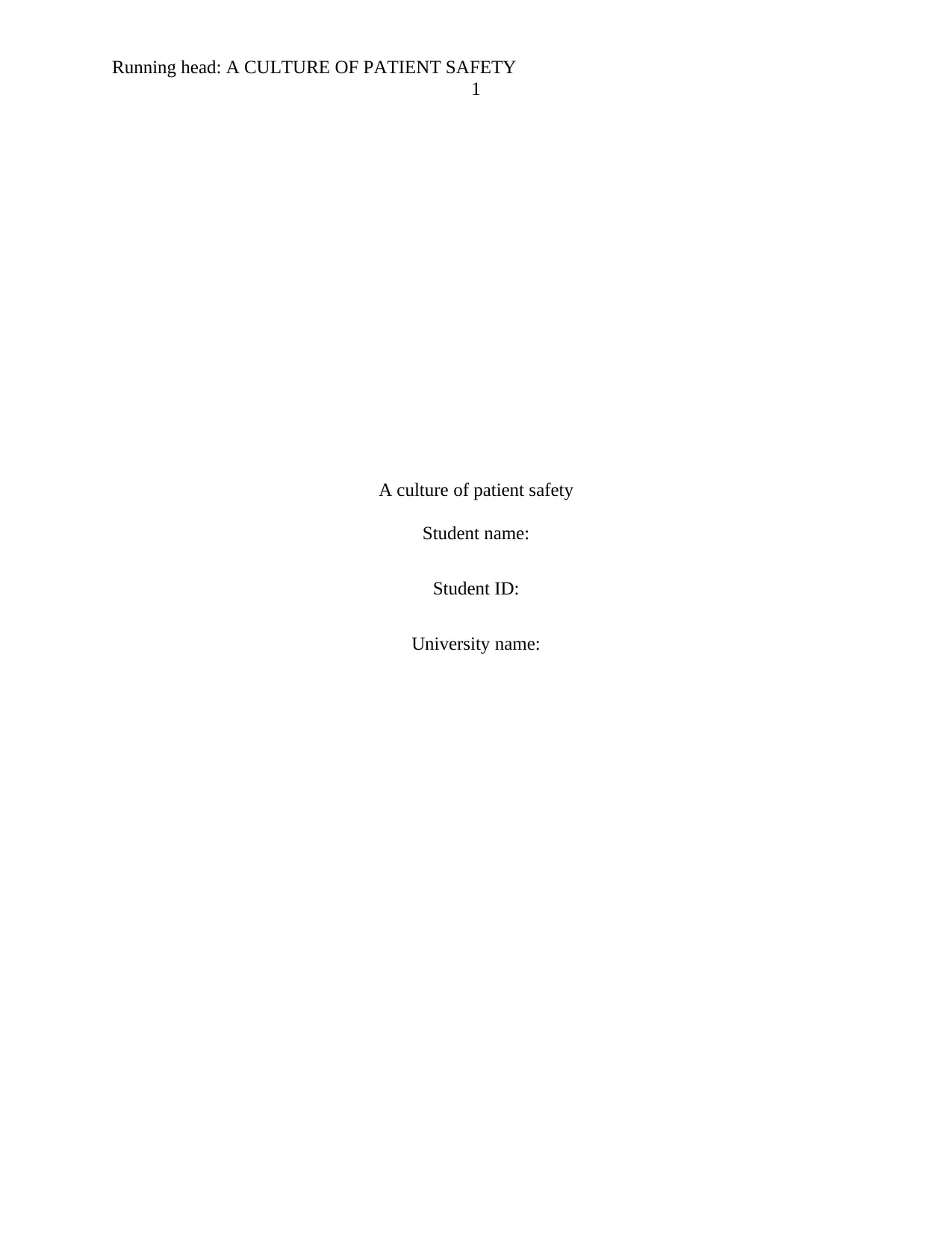
Running head: A CULTURE OF PATIENT SAFETY
1
A culture of patient safety
Student name:
Student ID:
University name:
1
A culture of patient safety
Student name:
Student ID:
University name:
Paraphrase This Document
Need a fresh take? Get an instant paraphrase of this document with our AI Paraphraser
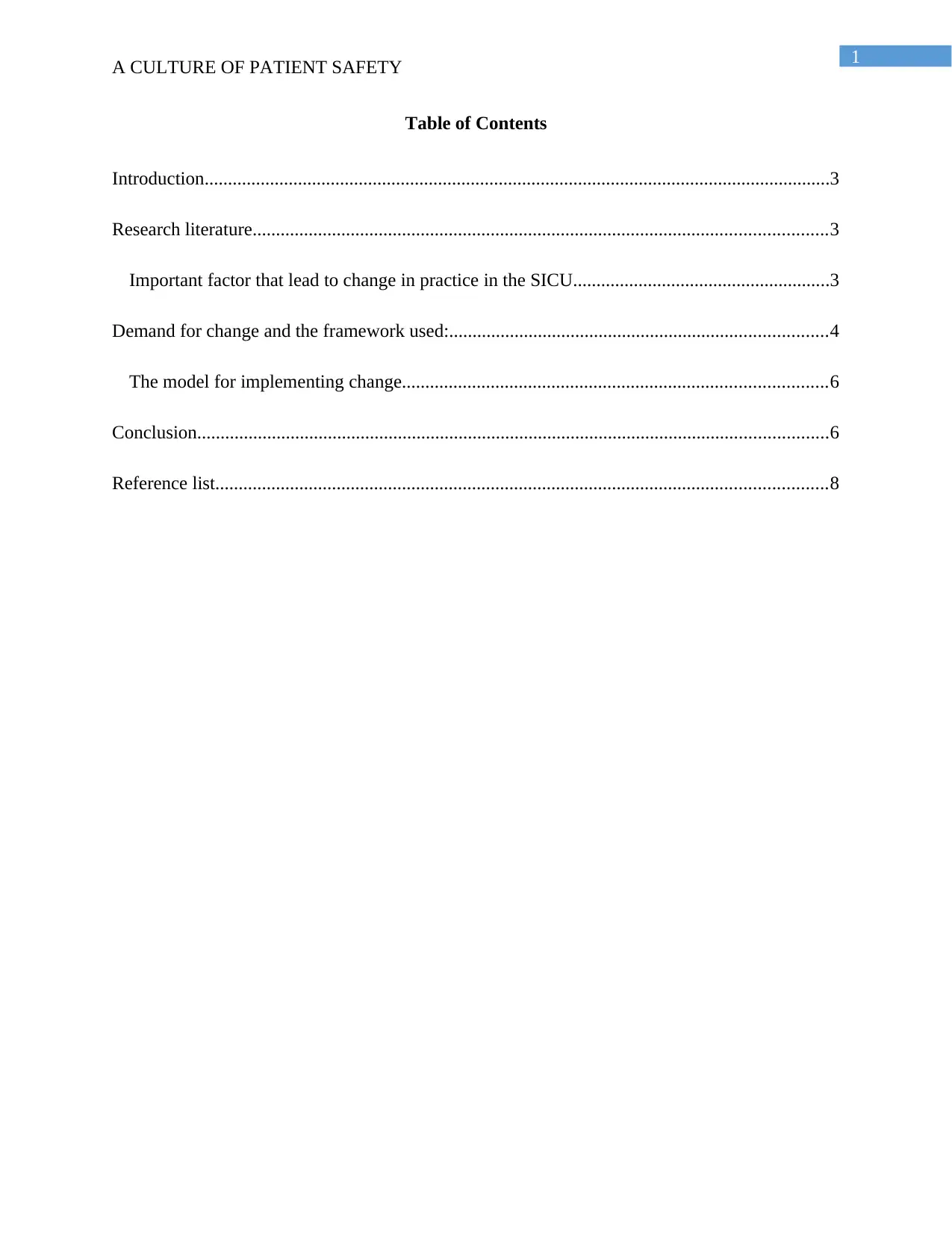
1
A CULTURE OF PATIENT SAFETY
Table of Contents
Introduction......................................................................................................................................3
Research literature...........................................................................................................................3
Important factor that lead to change in practice in the SICU.......................................................3
Demand for change and the framework used:.................................................................................4
The model for implementing change...........................................................................................6
Conclusion.......................................................................................................................................6
Reference list...................................................................................................................................8
A CULTURE OF PATIENT SAFETY
Table of Contents
Introduction......................................................................................................................................3
Research literature...........................................................................................................................3
Important factor that lead to change in practice in the SICU.......................................................3
Demand for change and the framework used:.................................................................................4
The model for implementing change...........................................................................................6
Conclusion.......................................................................................................................................6
Reference list...................................................................................................................................8
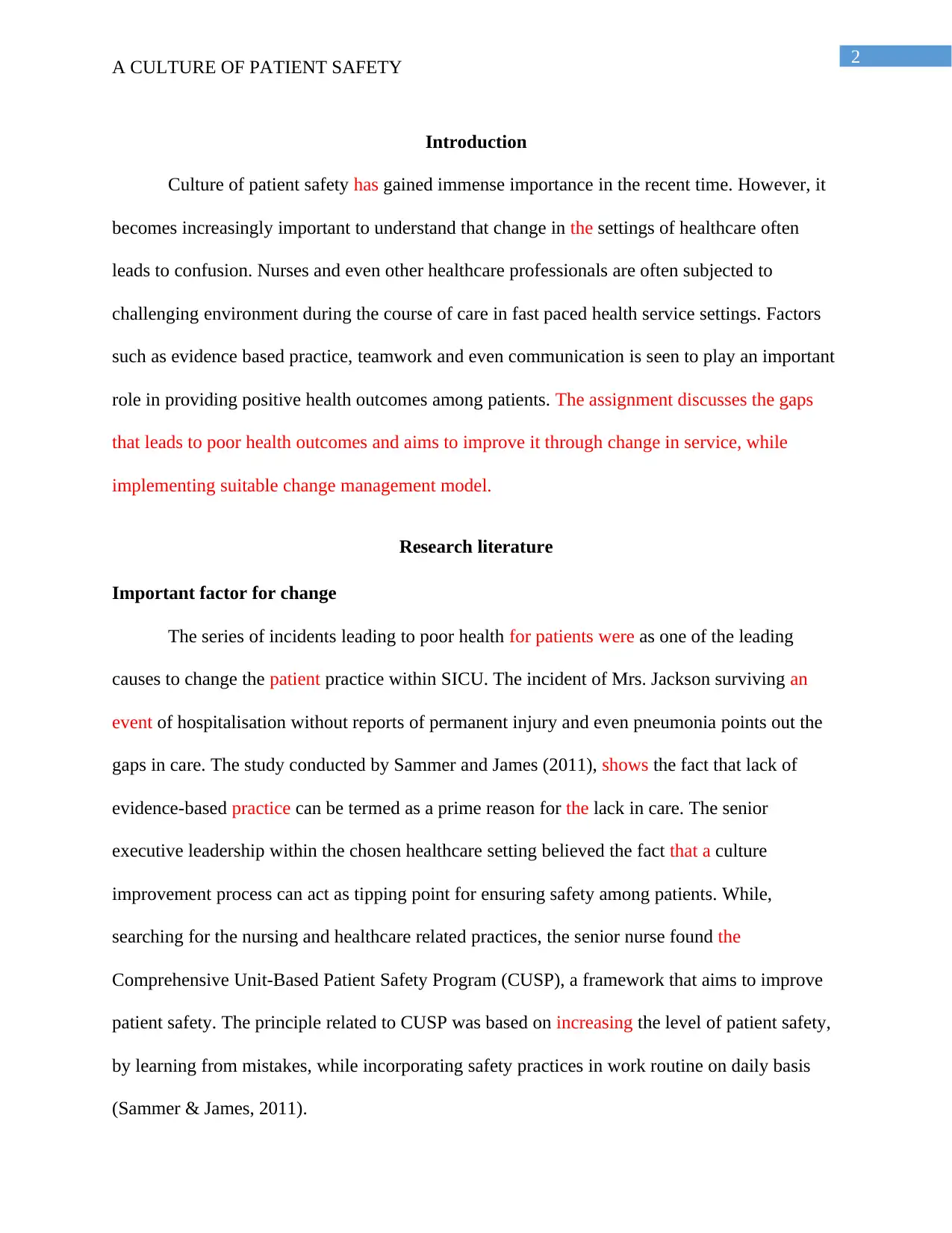
2
A CULTURE OF PATIENT SAFETY
Introduction
Culture of patient safety has gained immense importance in the recent time. However, it
becomes increasingly important to understand that change in the settings of healthcare often
leads to confusion. Nurses and even other healthcare professionals are often subjected to
challenging environment during the course of care in fast paced health service settings. Factors
such as evidence based practice, teamwork and even communication is seen to play an important
role in providing positive health outcomes among patients. The assignment discusses the gaps
that leads to poor health outcomes and aims to improve it through change in service, while
implementing suitable change management model.
Research literature
Important factor for change
The series of incidents leading to poor health for patients were as one of the leading
causes to change the patient practice within SICU. The incident of Mrs. Jackson surviving an
event of hospitalisation without reports of permanent injury and even pneumonia points out the
gaps in care. The study conducted by Sammer and James (2011), shows the fact that lack of
evidence-based practice can be termed as a prime reason for the lack in care. The senior
executive leadership within the chosen healthcare setting believed the fact that a culture
improvement process can act as tipping point for ensuring safety among patients. While,
searching for the nursing and healthcare related practices, the senior nurse found the
Comprehensive Unit-Based Patient Safety Program (CUSP), a framework that aims to improve
patient safety. The principle related to CUSP was based on increasing the level of patient safety,
by learning from mistakes, while incorporating safety practices in work routine on daily basis
(Sammer & James, 2011).
A CULTURE OF PATIENT SAFETY
Introduction
Culture of patient safety has gained immense importance in the recent time. However, it
becomes increasingly important to understand that change in the settings of healthcare often
leads to confusion. Nurses and even other healthcare professionals are often subjected to
challenging environment during the course of care in fast paced health service settings. Factors
such as evidence based practice, teamwork and even communication is seen to play an important
role in providing positive health outcomes among patients. The assignment discusses the gaps
that leads to poor health outcomes and aims to improve it through change in service, while
implementing suitable change management model.
Research literature
Important factor for change
The series of incidents leading to poor health for patients were as one of the leading
causes to change the patient practice within SICU. The incident of Mrs. Jackson surviving an
event of hospitalisation without reports of permanent injury and even pneumonia points out the
gaps in care. The study conducted by Sammer and James (2011), shows the fact that lack of
evidence-based practice can be termed as a prime reason for the lack in care. The senior
executive leadership within the chosen healthcare setting believed the fact that a culture
improvement process can act as tipping point for ensuring safety among patients. While,
searching for the nursing and healthcare related practices, the senior nurse found the
Comprehensive Unit-Based Patient Safety Program (CUSP), a framework that aims to improve
patient safety. The principle related to CUSP was based on increasing the level of patient safety,
by learning from mistakes, while incorporating safety practices in work routine on daily basis
(Sammer & James, 2011).
⊘ This is a preview!⊘
Do you want full access?
Subscribe today to unlock all pages.

Trusted by 1+ million students worldwide
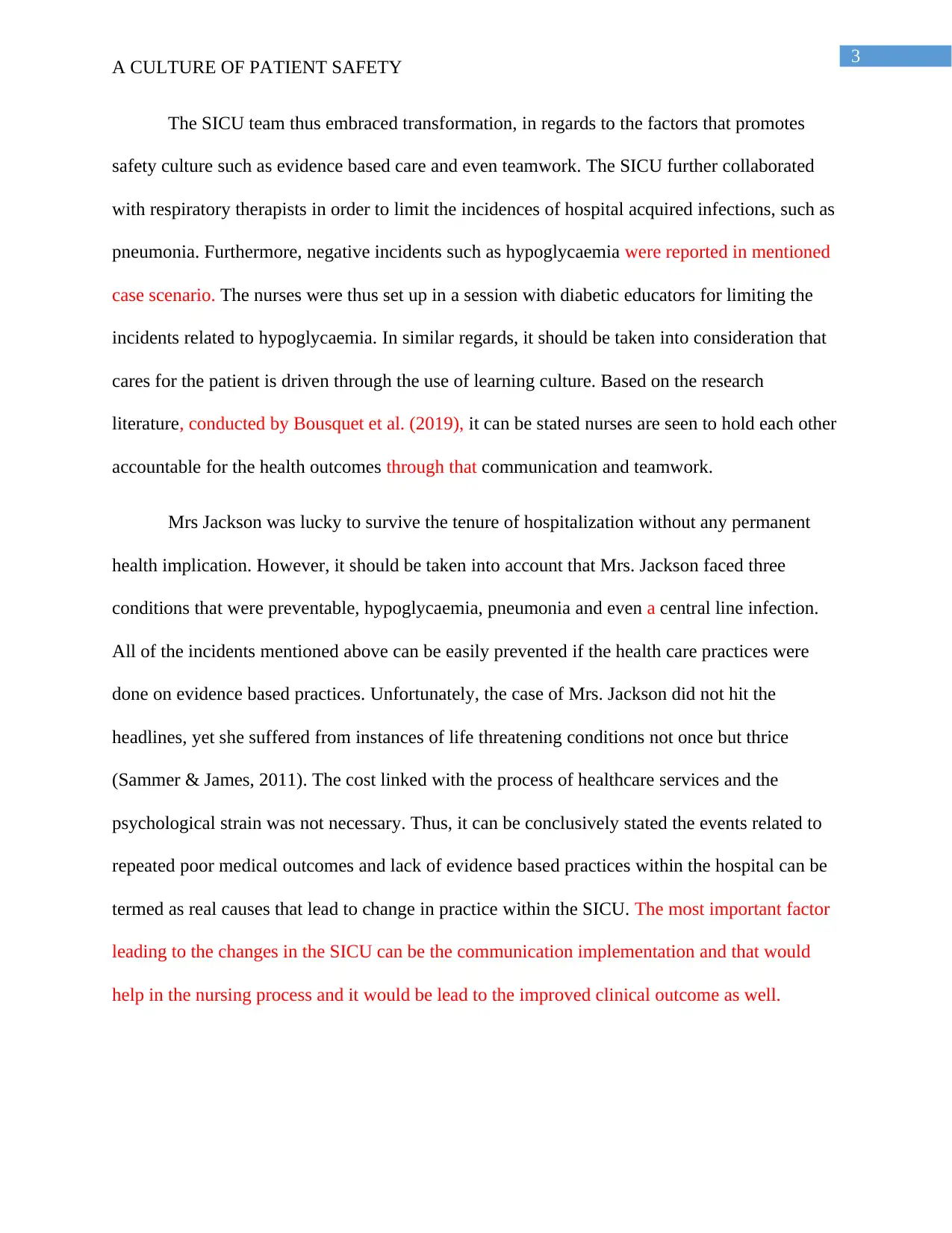
3
A CULTURE OF PATIENT SAFETY
The SICU team thus embraced transformation, in regards to the factors that promotes
safety culture such as evidence based care and even teamwork. The SICU further collaborated
with respiratory therapists in order to limit the incidences of hospital acquired infections, such as
pneumonia. Furthermore, negative incidents such as hypoglycaemia were reported in mentioned
case scenario. The nurses were thus set up in a session with diabetic educators for limiting the
incidents related to hypoglycaemia. In similar regards, it should be taken into consideration that
cares for the patient is driven through the use of learning culture. Based on the research
literature, conducted by Bousquet et al. (2019), it can be stated nurses are seen to hold each other
accountable for the health outcomes through that communication and teamwork.
Mrs Jackson was lucky to survive the tenure of hospitalization without any permanent
health implication. However, it should be taken into account that Mrs. Jackson faced three
conditions that were preventable, hypoglycaemia, pneumonia and even a central line infection.
All of the incidents mentioned above can be easily prevented if the health care practices were
done on evidence based practices. Unfortunately, the case of Mrs. Jackson did not hit the
headlines, yet she suffered from instances of life threatening conditions not once but thrice
(Sammer & James, 2011). The cost linked with the process of healthcare services and the
psychological strain was not necessary. Thus, it can be conclusively stated the events related to
repeated poor medical outcomes and lack of evidence based practices within the hospital can be
termed as real causes that lead to change in practice within the SICU. The most important factor
leading to the changes in the SICU can be the communication implementation and that would
help in the nursing process and it would be lead to the improved clinical outcome as well.
A CULTURE OF PATIENT SAFETY
The SICU team thus embraced transformation, in regards to the factors that promotes
safety culture such as evidence based care and even teamwork. The SICU further collaborated
with respiratory therapists in order to limit the incidences of hospital acquired infections, such as
pneumonia. Furthermore, negative incidents such as hypoglycaemia were reported in mentioned
case scenario. The nurses were thus set up in a session with diabetic educators for limiting the
incidents related to hypoglycaemia. In similar regards, it should be taken into consideration that
cares for the patient is driven through the use of learning culture. Based on the research
literature, conducted by Bousquet et al. (2019), it can be stated nurses are seen to hold each other
accountable for the health outcomes through that communication and teamwork.
Mrs Jackson was lucky to survive the tenure of hospitalization without any permanent
health implication. However, it should be taken into account that Mrs. Jackson faced three
conditions that were preventable, hypoglycaemia, pneumonia and even a central line infection.
All of the incidents mentioned above can be easily prevented if the health care practices were
done on evidence based practices. Unfortunately, the case of Mrs. Jackson did not hit the
headlines, yet she suffered from instances of life threatening conditions not once but thrice
(Sammer & James, 2011). The cost linked with the process of healthcare services and the
psychological strain was not necessary. Thus, it can be conclusively stated the events related to
repeated poor medical outcomes and lack of evidence based practices within the hospital can be
termed as real causes that lead to change in practice within the SICU. The most important factor
leading to the changes in the SICU can be the communication implementation and that would
help in the nursing process and it would be lead to the improved clinical outcome as well.
Paraphrase This Document
Need a fresh take? Get an instant paraphrase of this document with our AI Paraphraser
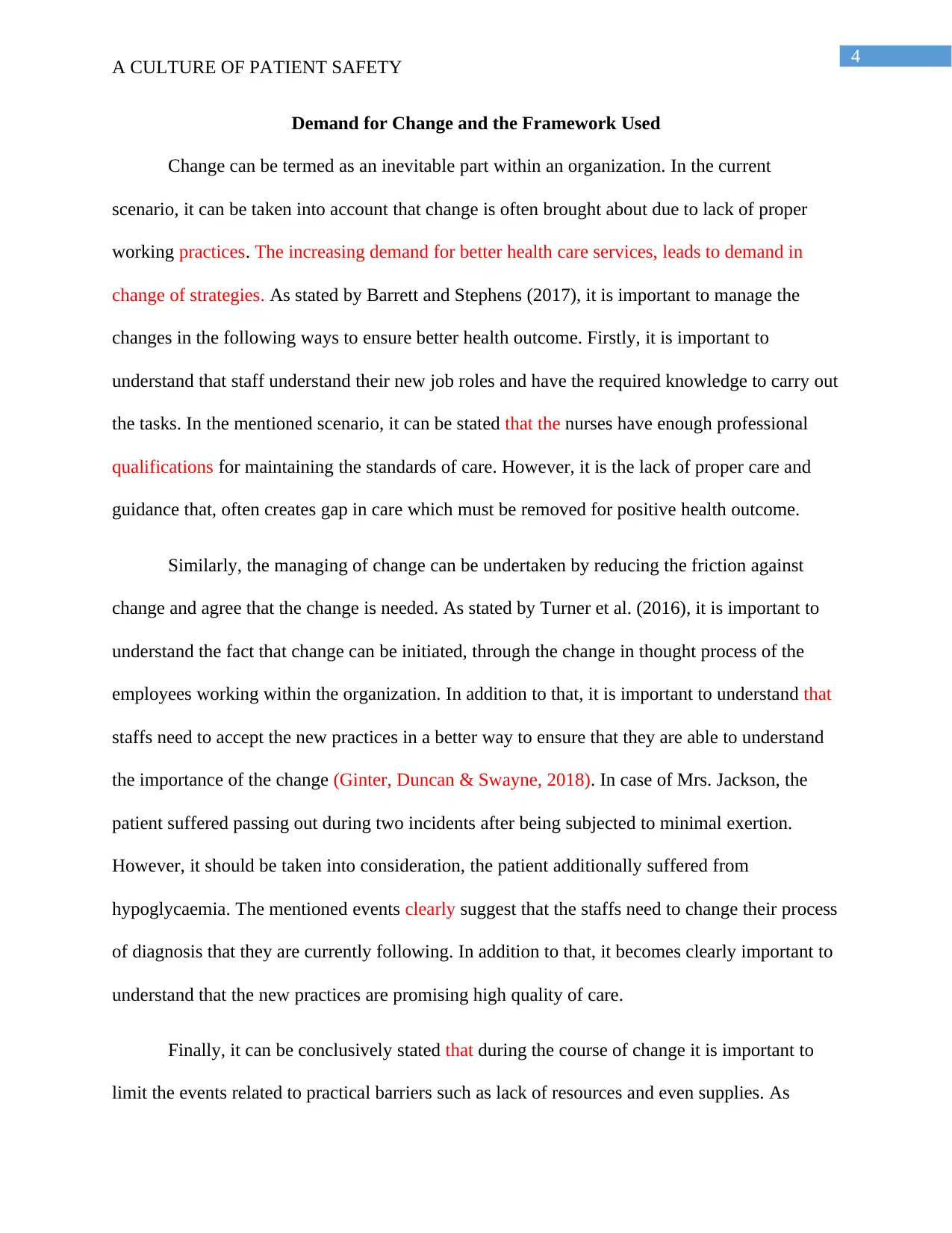
4
A CULTURE OF PATIENT SAFETY
Demand for Change and the Framework Used
Change can be termed as an inevitable part within an organization. In the current
scenario, it can be taken into account that change is often brought about due to lack of proper
working practices. The increasing demand for better health care services, leads to demand in
change of strategies. As stated by Barrett and Stephens (2017), it is important to manage the
changes in the following ways to ensure better health outcome. Firstly, it is important to
understand that staff understand their new job roles and have the required knowledge to carry out
the tasks. In the mentioned scenario, it can be stated that the nurses have enough professional
qualifications for maintaining the standards of care. However, it is the lack of proper care and
guidance that, often creates gap in care which must be removed for positive health outcome.
Similarly, the managing of change can be undertaken by reducing the friction against
change and agree that the change is needed. As stated by Turner et al. (2016), it is important to
understand the fact that change can be initiated, through the change in thought process of the
employees working within the organization. In addition to that, it is important to understand that
staffs need to accept the new practices in a better way to ensure that they are able to understand
the importance of the change (Ginter, Duncan & Swayne, 2018). In case of Mrs. Jackson, the
patient suffered passing out during two incidents after being subjected to minimal exertion.
However, it should be taken into consideration, the patient additionally suffered from
hypoglycaemia. The mentioned events clearly suggest that the staffs need to change their process
of diagnosis that they are currently following. In addition to that, it becomes clearly important to
understand that the new practices are promising high quality of care.
Finally, it can be conclusively stated that during the course of change it is important to
limit the events related to practical barriers such as lack of resources and even supplies. As
A CULTURE OF PATIENT SAFETY
Demand for Change and the Framework Used
Change can be termed as an inevitable part within an organization. In the current
scenario, it can be taken into account that change is often brought about due to lack of proper
working practices. The increasing demand for better health care services, leads to demand in
change of strategies. As stated by Barrett and Stephens (2017), it is important to manage the
changes in the following ways to ensure better health outcome. Firstly, it is important to
understand that staff understand their new job roles and have the required knowledge to carry out
the tasks. In the mentioned scenario, it can be stated that the nurses have enough professional
qualifications for maintaining the standards of care. However, it is the lack of proper care and
guidance that, often creates gap in care which must be removed for positive health outcome.
Similarly, the managing of change can be undertaken by reducing the friction against
change and agree that the change is needed. As stated by Turner et al. (2016), it is important to
understand the fact that change can be initiated, through the change in thought process of the
employees working within the organization. In addition to that, it is important to understand that
staffs need to accept the new practices in a better way to ensure that they are able to understand
the importance of the change (Ginter, Duncan & Swayne, 2018). In case of Mrs. Jackson, the
patient suffered passing out during two incidents after being subjected to minimal exertion.
However, it should be taken into consideration, the patient additionally suffered from
hypoglycaemia. The mentioned events clearly suggest that the staffs need to change their process
of diagnosis that they are currently following. In addition to that, it becomes clearly important to
understand that the new practices are promising high quality of care.
Finally, it can be conclusively stated that during the course of change it is important to
limit the events related to practical barriers such as lack of resources and even supplies. As
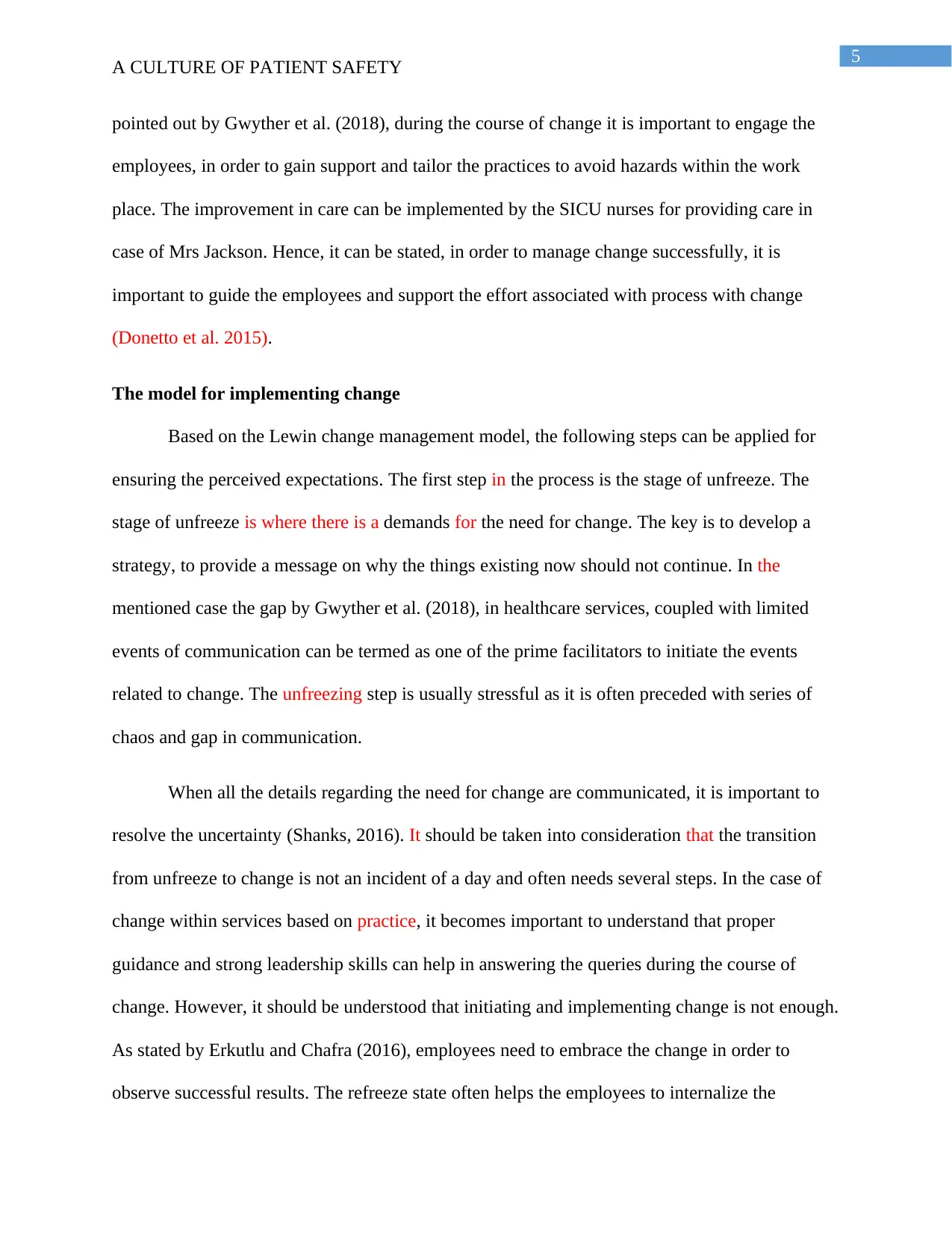
5
A CULTURE OF PATIENT SAFETY
pointed out by Gwyther et al. (2018), during the course of change it is important to engage the
employees, in order to gain support and tailor the practices to avoid hazards within the work
place. The improvement in care can be implemented by the SICU nurses for providing care in
case of Mrs Jackson. Hence, it can be stated, in order to manage change successfully, it is
important to guide the employees and support the effort associated with process with change
(Donetto et al. 2015).
The model for implementing change
Based on the Lewin change management model, the following steps can be applied for
ensuring the perceived expectations. The first step in the process is the stage of unfreeze. The
stage of unfreeze is where there is a demands for the need for change. The key is to develop a
strategy, to provide a message on why the things existing now should not continue. In the
mentioned case the gap by Gwyther et al. (2018), in healthcare services, coupled with limited
events of communication can be termed as one of the prime facilitators to initiate the events
related to change. The unfreezing step is usually stressful as it is often preceded with series of
chaos and gap in communication.
When all the details regarding the need for change are communicated, it is important to
resolve the uncertainty (Shanks, 2016). It should be taken into consideration that the transition
from unfreeze to change is not an incident of a day and often needs several steps. In the case of
change within services based on practice, it becomes important to understand that proper
guidance and strong leadership skills can help in answering the queries during the course of
change. However, it should be understood that initiating and implementing change is not enough.
As stated by Erkutlu and Chafra (2016), employees need to embrace the change in order to
observe successful results. The refreeze state often helps the employees to internalize the
A CULTURE OF PATIENT SAFETY
pointed out by Gwyther et al. (2018), during the course of change it is important to engage the
employees, in order to gain support and tailor the practices to avoid hazards within the work
place. The improvement in care can be implemented by the SICU nurses for providing care in
case of Mrs Jackson. Hence, it can be stated, in order to manage change successfully, it is
important to guide the employees and support the effort associated with process with change
(Donetto et al. 2015).
The model for implementing change
Based on the Lewin change management model, the following steps can be applied for
ensuring the perceived expectations. The first step in the process is the stage of unfreeze. The
stage of unfreeze is where there is a demands for the need for change. The key is to develop a
strategy, to provide a message on why the things existing now should not continue. In the
mentioned case the gap by Gwyther et al. (2018), in healthcare services, coupled with limited
events of communication can be termed as one of the prime facilitators to initiate the events
related to change. The unfreezing step is usually stressful as it is often preceded with series of
chaos and gap in communication.
When all the details regarding the need for change are communicated, it is important to
resolve the uncertainty (Shanks, 2016). It should be taken into consideration that the transition
from unfreeze to change is not an incident of a day and often needs several steps. In the case of
change within services based on practice, it becomes important to understand that proper
guidance and strong leadership skills can help in answering the queries during the course of
change. However, it should be understood that initiating and implementing change is not enough.
As stated by Erkutlu and Chafra (2016), employees need to embrace the change in order to
observe successful results. The refreeze state often helps the employees to internalize the
⊘ This is a preview!⊘
Do you want full access?
Subscribe today to unlock all pages.

Trusted by 1+ million students worldwide
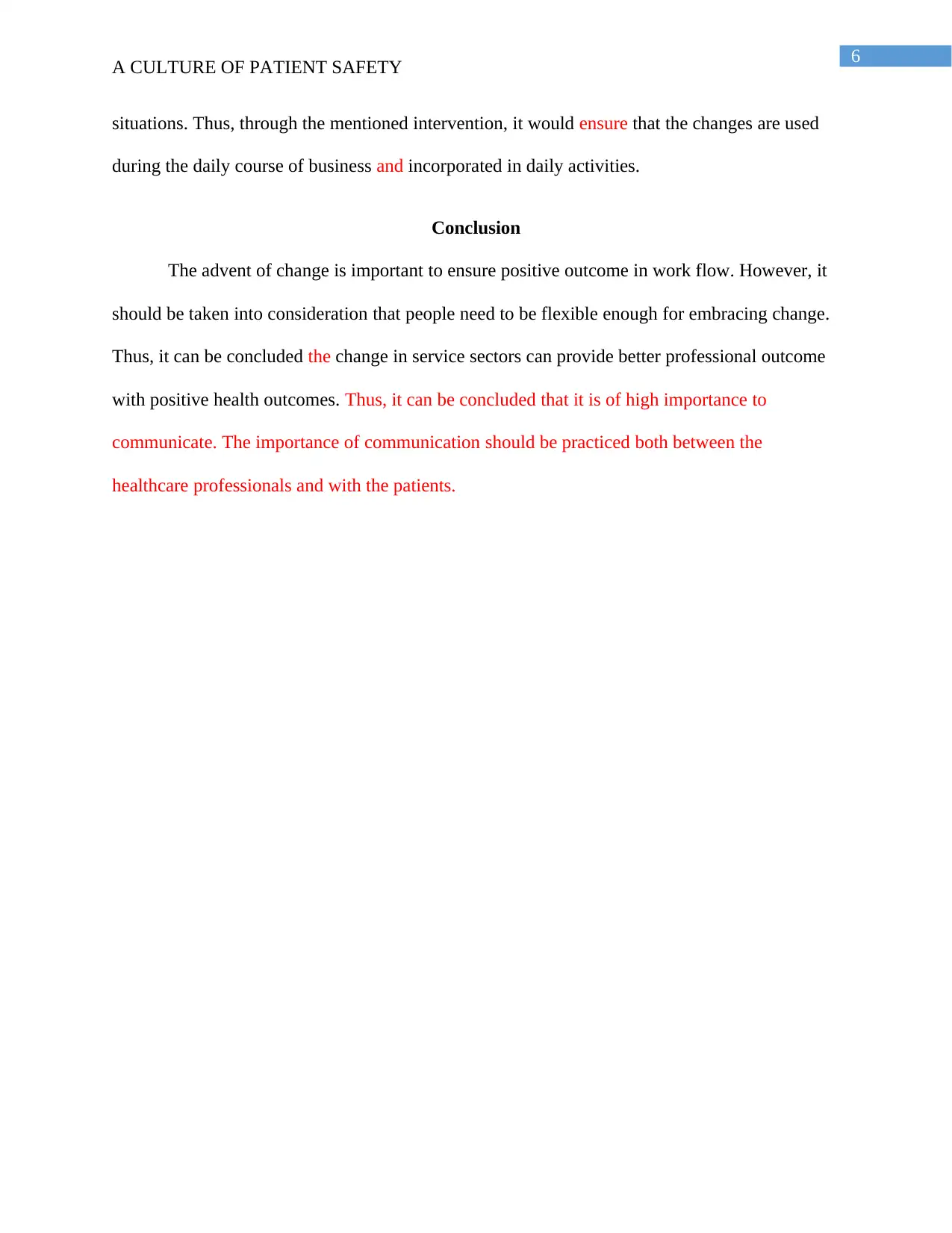
6
A CULTURE OF PATIENT SAFETY
situations. Thus, through the mentioned intervention, it would ensure that the changes are used
during the daily course of business and incorporated in daily activities.
Conclusion
The advent of change is important to ensure positive outcome in work flow. However, it
should be taken into consideration that people need to be flexible enough for embracing change.
Thus, it can be concluded the change in service sectors can provide better professional outcome
with positive health outcomes. Thus, it can be concluded that it is of high importance to
communicate. The importance of communication should be practiced both between the
healthcare professionals and with the patients.
A CULTURE OF PATIENT SAFETY
situations. Thus, through the mentioned intervention, it would ensure that the changes are used
during the daily course of business and incorporated in daily activities.
Conclusion
The advent of change is important to ensure positive outcome in work flow. However, it
should be taken into consideration that people need to be flexible enough for embracing change.
Thus, it can be concluded the change in service sectors can provide better professional outcome
with positive health outcomes. Thus, it can be concluded that it is of high importance to
communicate. The importance of communication should be practiced both between the
healthcare professionals and with the patients.
Paraphrase This Document
Need a fresh take? Get an instant paraphrase of this document with our AI Paraphraser
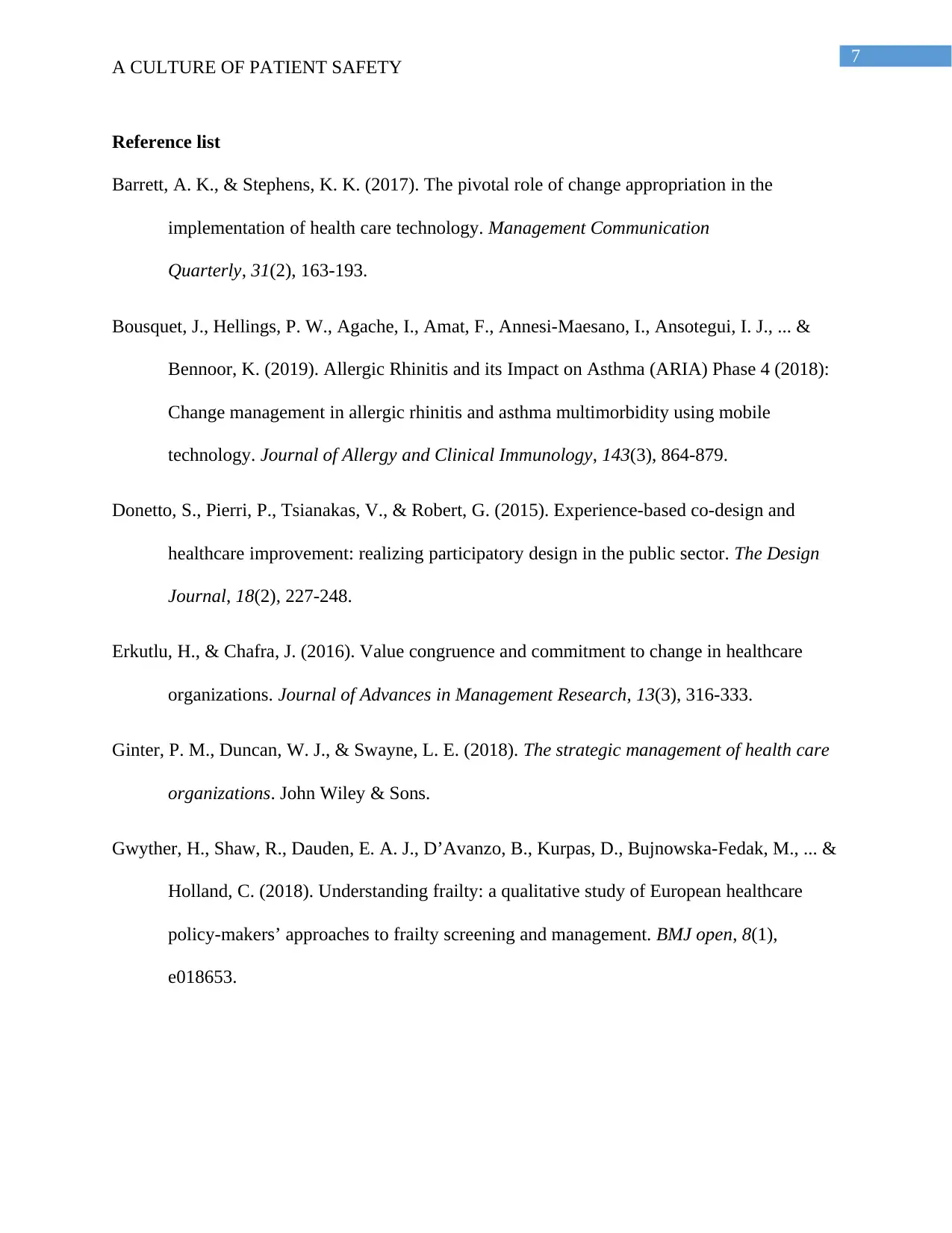
7
A CULTURE OF PATIENT SAFETY
Reference list
Barrett, A. K., & Stephens, K. K. (2017). The pivotal role of change appropriation in the
implementation of health care technology. Management Communication
Quarterly, 31(2), 163-193.
Bousquet, J., Hellings, P. W., Agache, I., Amat, F., Annesi-Maesano, I., Ansotegui, I. J., ... &
Bennoor, K. (2019). Allergic Rhinitis and its Impact on Asthma (ARIA) Phase 4 (2018):
Change management in allergic rhinitis and asthma multimorbidity using mobile
technology. Journal of Allergy and Clinical Immunology, 143(3), 864-879.
Donetto, S., Pierri, P., Tsianakas, V., & Robert, G. (2015). Experience-based co-design and
healthcare improvement: realizing participatory design in the public sector. The Design
Journal, 18(2), 227-248.
Erkutlu, H., & Chafra, J. (2016). Value congruence and commitment to change in healthcare
organizations. Journal of Advances in Management Research, 13(3), 316-333.
Ginter, P. M., Duncan, W. J., & Swayne, L. E. (2018). The strategic management of health care
organizations. John Wiley & Sons.
Gwyther, H., Shaw, R., Dauden, E. A. J., D’Avanzo, B., Kurpas, D., Bujnowska-Fedak, M., ... &
Holland, C. (2018). Understanding frailty: a qualitative study of European healthcare
policy-makers’ approaches to frailty screening and management. BMJ open, 8(1),
e018653.
A CULTURE OF PATIENT SAFETY
Reference list
Barrett, A. K., & Stephens, K. K. (2017). The pivotal role of change appropriation in the
implementation of health care technology. Management Communication
Quarterly, 31(2), 163-193.
Bousquet, J., Hellings, P. W., Agache, I., Amat, F., Annesi-Maesano, I., Ansotegui, I. J., ... &
Bennoor, K. (2019). Allergic Rhinitis and its Impact on Asthma (ARIA) Phase 4 (2018):
Change management in allergic rhinitis and asthma multimorbidity using mobile
technology. Journal of Allergy and Clinical Immunology, 143(3), 864-879.
Donetto, S., Pierri, P., Tsianakas, V., & Robert, G. (2015). Experience-based co-design and
healthcare improvement: realizing participatory design in the public sector. The Design
Journal, 18(2), 227-248.
Erkutlu, H., & Chafra, J. (2016). Value congruence and commitment to change in healthcare
organizations. Journal of Advances in Management Research, 13(3), 316-333.
Ginter, P. M., Duncan, W. J., & Swayne, L. E. (2018). The strategic management of health care
organizations. John Wiley & Sons.
Gwyther, H., Shaw, R., Dauden, E. A. J., D’Avanzo, B., Kurpas, D., Bujnowska-Fedak, M., ... &
Holland, C. (2018). Understanding frailty: a qualitative study of European healthcare
policy-makers’ approaches to frailty screening and management. BMJ open, 8(1),
e018653.
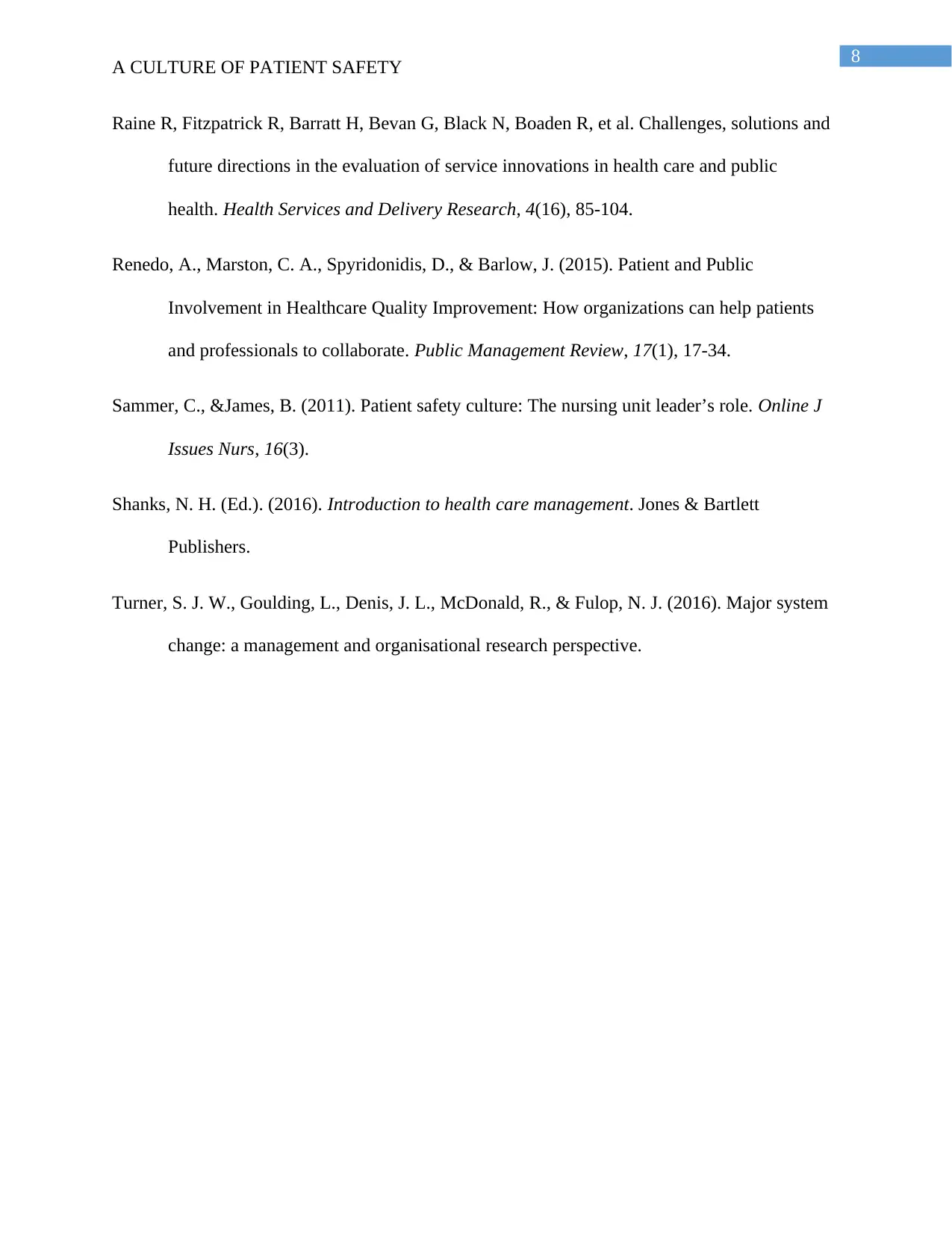
8
A CULTURE OF PATIENT SAFETY
Raine R, Fitzpatrick R, Barratt H, Bevan G, Black N, Boaden R, et al. Challenges, solutions and
future directions in the evaluation of service innovations in health care and public
health. Health Services and Delivery Research, 4(16), 85-104.
Renedo, A., Marston, C. A., Spyridonidis, D., & Barlow, J. (2015). Patient and Public
Involvement in Healthcare Quality Improvement: How organizations can help patients
and professionals to collaborate. Public Management Review, 17(1), 17-34.
Sammer, C., &James, B. (2011). Patient safety culture: The nursing unit leader’s role. Online J
Issues Nurs, 16(3).
Shanks, N. H. (Ed.). (2016). Introduction to health care management. Jones & Bartlett
Publishers.
Turner, S. J. W., Goulding, L., Denis, J. L., McDonald, R., & Fulop, N. J. (2016). Major system
change: a management and organisational research perspective.
A CULTURE OF PATIENT SAFETY
Raine R, Fitzpatrick R, Barratt H, Bevan G, Black N, Boaden R, et al. Challenges, solutions and
future directions in the evaluation of service innovations in health care and public
health. Health Services and Delivery Research, 4(16), 85-104.
Renedo, A., Marston, C. A., Spyridonidis, D., & Barlow, J. (2015). Patient and Public
Involvement in Healthcare Quality Improvement: How organizations can help patients
and professionals to collaborate. Public Management Review, 17(1), 17-34.
Sammer, C., &James, B. (2011). Patient safety culture: The nursing unit leader’s role. Online J
Issues Nurs, 16(3).
Shanks, N. H. (Ed.). (2016). Introduction to health care management. Jones & Bartlett
Publishers.
Turner, S. J. W., Goulding, L., Denis, J. L., McDonald, R., & Fulop, N. J. (2016). Major system
change: a management and organisational research perspective.
⊘ This is a preview!⊘
Do you want full access?
Subscribe today to unlock all pages.

Trusted by 1+ million students worldwide
1 out of 9
Related Documents
Your All-in-One AI-Powered Toolkit for Academic Success.
+13062052269
info@desklib.com
Available 24*7 on WhatsApp / Email
![[object Object]](/_next/static/media/star-bottom.7253800d.svg)
Unlock your academic potential
Copyright © 2020–2025 A2Z Services. All Rights Reserved. Developed and managed by ZUCOL.





